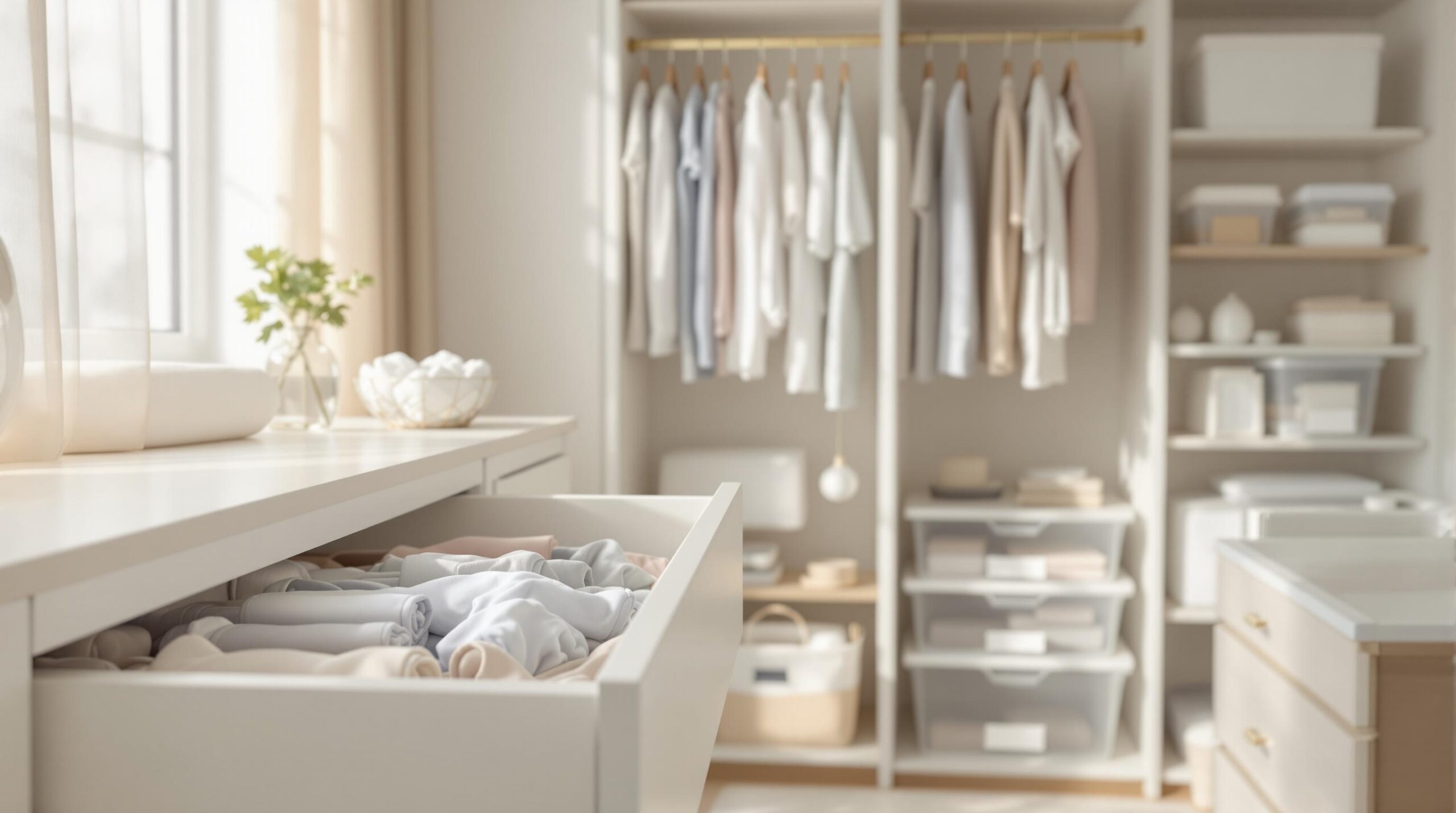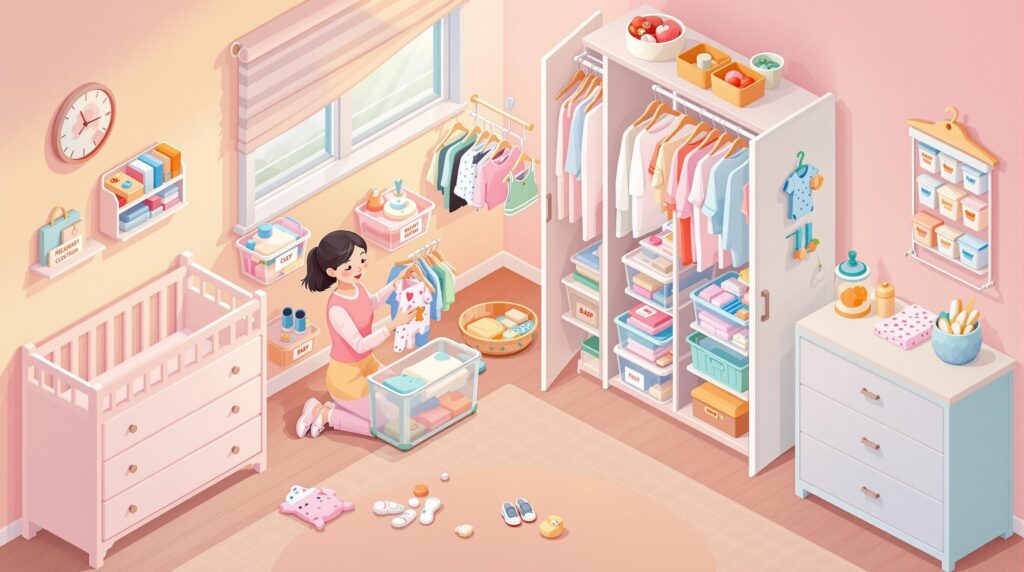Table of Contents
ToggleBecoming a parent is an exciting journey filled with joy, love, and, let’s face it, a whole lot of baby stuff! As your little one grows, you’ll quickly realize that organizing baby clothes and essentials is not just a nice-to-have skill—it’s a must-have superpower. Trust me, I’ve been there, and I’m here to share some tried-and-true strategies to keep your baby’s belongings in order without drowning in clutter.
The Importance of Organizing Baby Clothes and Essentials
You might be wondering, “Is it really that important to keep all those tiny socks and onesies perfectly organized?” The answer is a resounding yes! Here’s why:
- Stress Reduction: When you know exactly where everything is, you’ll feel more in control and less frazzled during those hectic moments (and there will be many!).
- Time-Saving: No more frantically searching for a clean outfit while your baby is wailing for a diaper change. You’ll have everything at your fingertips.
- Prevent Overbuying: With a clear view of what you have, you’re less likely to buy duplicates or unnecessary items.
- Easy Access: When you need something, you can grab it quickly—a real lifesaver during those middle-of-the-night feedings.
By implementing a solid organization system, you’re setting yourself up for success in your parenting journey. It’s not just about tidiness; it’s about creating a smooth-running household that allows you to focus on what really matters—enjoying time with your little one.

Start with Categorizing and Purging
Before you dive into organizing, it’s crucial to take stock of what you have and get rid of what you don’t need. This process might seem overwhelming, but I promise it’s worth it.
Sort Clothes into Categories
Begin by sorting all baby clothes into clear categories. This might include:
- Onesies
- Sleepers
- Outerwear
- Socks and Mittens
- Special Occasion Outfits
By grouping similar items together, you’ll get a better sense of what you have and what you might be missing. It also makes it easier to choose the right baby gear for your daily needs.
Remove Unnecessary Items
Now comes the hard part—letting go. Remove items that are:
- Too small
- Stained beyond repair
- No longer needed for the current season
Be ruthless here. If you haven’t used an item in the last month and it’s not a special keepsake, it’s probably time to let it go.
Donate or Store Outgrown Clothes
For clothes in good condition that your baby has outgrown, consider donating them to local charities or passing them on to friends with younger children. If you’re planning on having more children, store these items in clearly labeled bins for future use.
Regular Purging Prevents Clutter Buildup
Make this process a regular habit—maybe once a month or with each growth spurt. This prevents clutter from accumulating and keeps your baby’s wardrobe current and manageable.
Implement Effective Storage Solutions
Now that you’ve pared down to the essentials, it’s time to find a home for everything. The right storage solutions can make all the difference in maintaining order.
Use Stackable Containers
Stackable containers are a parent’s best friend. They maximize vertical space and keep things neatly contained. Opt for containers with lids to protect clothes from dust and make them easily stackable. A fun fact: using stackable containers can reduce clutter by up to 30%!
Utilize Clear Bins
Clear bins are a game-changer. They allow you to see the contents at a glance, saving you time and frustration. No more digging through opaque boxes to find that one specific outfit!
Label Each Bin
Take a few extra minutes to label each bin clearly. You can use categories like “3-6 months summer clothes” or “winter accessories.” This simple step will save you countless hours in the long run and make it easy for anyone helping with the baby to find what they need.
Maximize Closet Space
Your baby’s closet, no matter how small, can be a powerhouse of organization with the right approach.
Install Double Rods
Double the hanging space by installing a second rod below the existing one. This works great for baby clothes since they’re so small. You can hang onesies, dresses, and jackets on both levels, effectively doubling your storage capacity.
Add Shelves for Folded Items
Install shelves above the rods for items that don’t need to be hung. This is perfect for stacks of folded onesies, pants, or even diapers and wipes. You can also use these shelves to store bins with smaller items like socks and bibs.
Use Vertical Space Wisely
Don’t forget about the back of the closet door and empty wall space. Over-the-door organizers can hold shoes, accessories, or even diapering supplies. Wall-mounted baskets or pockets can be great for storing small items like pacifiers or hair accessories.
Master Folding and Hanging Techniques
The way you fold and hang clothes can significantly impact how much you can store and how easily you can access items.
KonMari Folding Method
The KonMari method, popularized by Marie Kondo, involves folding clothes into compact rectangles that can stand upright. This method can increase drawer storage capacity by up to 50%! Here’s how to do it:
- Lay the item flat.
- Fold in the sides to create a rectangle.
- Fold the rectangle into thirds.
- Stand the folded piece upright.
This technique works wonderfully for onesies, t-shirts, and pants.
Drawer Organization
Once clothes are folded, place them vertically in drawers like files in a filing cabinet. This allows you to see every item at once and grab what you need without disturbing the rest.
Efficient Hanging
For items that need to be hung, use slim velvet hangers to maximize space. Group similar items together and arrange them by color for easy selection. Don’t forget to use baby-friendly hangers that won’t damage delicate clothes.
Implement a Seasonal Rotation System
Babies grow quickly, and their clothing needs change with the seasons. A seasonal rotation system keeps your current storage manageable and ensures you’re prepared for the next season.
Separate Clothes by Season
As you organize, separate clothes into seasonal categories: spring/summer and fall/winter. This makes it easier to access what you need now and store what you’ll need later.
Store Out-of-Season Clothes
Pack away out-of-season clothes in labeled bins or vacuum-sealed bags. These can be stored in less accessible areas like under the bed or in a closet’s upper shelves.
Rotate Seasonal Items
Set reminders to rotate your baby’s wardrobe every few months or as the seasons change. This is also a great time to reassess what still fits and what needs to be donated or stored for future siblings.
Ensure Safety in Storage
While organizing, it’s crucial to keep safety in mind. A tidy nursery shouldn’t come at the cost of your baby’s well-being.
Secure Storage Solutions
Choose storage furniture that’s sturdy and won’t tip over. Safety guidelines recommend anchoring dressers, bookcases, and other large storage units to the walls to prevent accidents.
Avoid Choking Hazards
Be mindful of small parts that could become choking hazards. This includes things like decorative knobs on dressers or small organizational bins that a curious baby might get into.
Keep Essentials Within Reach
Organize your space so that frequently used items are easily accessible. This reduces the need to stretch or climb while holding your baby. Keep diaper bag essentials in a designated spot for quick grabs when heading out.
Establish a Maintenance Routine
The key to long-term organization success is consistency. Establish a routine to keep your systems in check.
Weekly Quick Tidy
Set aside 10-15 minutes each week for a quick organization session. This might include:
- Putting away clean laundry
- Removing any outgrown clothes
- Restocking essentials like diapers and wipes
Involve Family Members
If you have a partner or older children, involve them in the process. Assign specific tasks to each family member, like folding and putting away laundry or restocking diaper stations.
Monthly Review
Once a month, take a more comprehensive look at your organization system. This is a good time to:
- Rotate seasonal clothing
- Reassess storage solutions
- Plan for upcoming size changes
By staying on top of organization, you’ll prevent the overwhelming buildup that can occur when things are left unchecked.
Final Thoughts
Organizing baby clothes and essentials might seem like a never-ending task, but with these strategies in place, you’ll find it becomes second nature. Remember, the goal isn’t perfection—it’s creating a system that works for you and your family. As you implement these tips, you’ll find you have more time to focus on what really matters: enjoying those precious moments with your little one.
And here’s a parting tip: as you get your baby’s things in order, don’t forget to create a baby budget to keep your finances as organized as your nursery. Happy organizing, and enjoy this wonderful journey of parenthood!
Sources:
U.S. Department of Health and Human Services – National Institute of Child Health and Human Development
Consumer Education Websites: A Guide to Creating a Family-Friendly Experience
Section 508 Accessibility Guidelines












